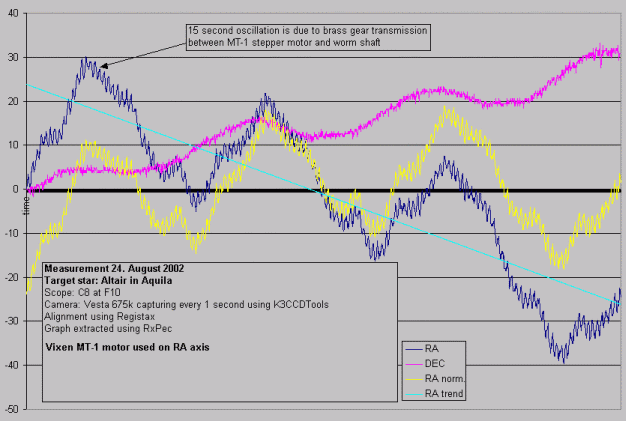
High frequency second order periodic error using MT-1 motors.
Some problems observed:
I no longer have the DA-1. Instead, I use the Boxdoerfer MTS3SDI.
I originally used the Vixen MT-1 RA motor and SD-1 controller on my mount, but measurements of the periodic error showed that the "normal" PE curve had a high frequency error superimposed. My analysis was that this error was due to the spur gears between RA motor (Vixen MT-1) and worm shaft. The worm period is 10 minutes for the Super Polaris mount and the gears have 40 teeth. It takes 15 seconds between each tooth engagement, and somehow this creates a second order periodic error that even autoguiding will have trouble with. I tried several motor adjustments, but the problem persisted, so I started looking for alternatives.

I also wanted computer control to allow autoguiding. After some research, I found that Astromeccanica's DA-1 used a belt drive system and had an option for computer control. After a while the order was placed, and on December 8, 2002 the conversion was done:

The SP mount turned out to be compatible with the DA-1 as promised, but I guess the GP-DX is even more compatible. On the SP, the RA motor must be kept in position using 4 small adjustment screws only (on the GP a larger screw does a better job). Also, The MT-1 motor has a V-shaped adapter block that is designed for this type of attachment (see image below). The adapter block on the DA-1 is different but tests with the DA-1 motor proves it attaches adequately to the SP mount.

The second issue I saw was that my RA worm shaft is a little short, so the DA-1 pulley could only just be adapted and still let the belt run freely.
The proof of the pudding is in the eating, so when the skies cleared up on the same day the motors were mounted (after 1+ month of clouds+snow) I did a periodic error test.
The result of the periodic error test is seen below. The high frequency periodic error is gone! No autoguiding or any other adjustment was done in this test, so the main periodic error is still there, but it is much smoother. All in all, a successful first installation and test. Further tests found other problems though, see top of this page.
